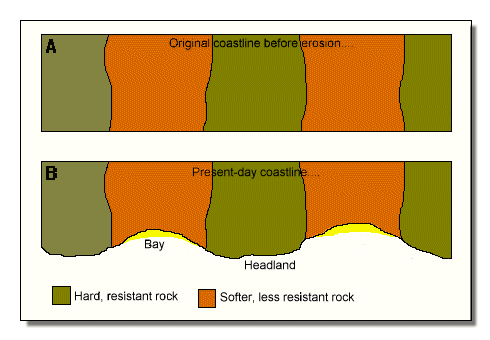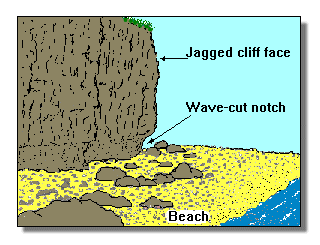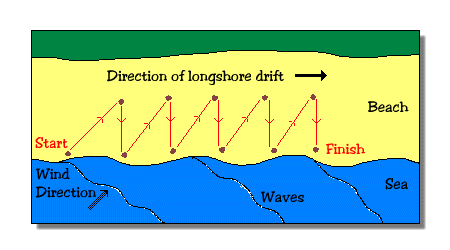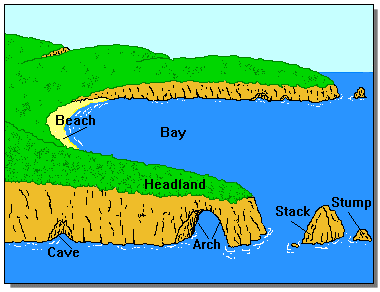

 |
 |
Land and sea meet along the coastline. The U.K. has a coastline which is 7,500 miles long. The coast is shaped mainly by the action of the waves which reach the shore. Waves are created by the winds which blow across the surface. Friction results in the transfer of energy from the wind to the waves. The size of the waves depends on three factors:
The most common direction in which the waves move is determined by the prevailing winds i.e. the direction from which the winds blow most often. In the U.K., the prevailing winds are from the south-west which is also the direction of longest fetch. A wave will break when it reaches shallow water. As the water rushes up the beach it forms the swash and as it returns down the beach, the backwash. Some waves build up beach material [constructive waves] whilst others drag sand and pebbles down the beach [destructive waves]. Waves erode or wear away the coast and transport the eroded material along the coastline - a process called longshore drift. Eventually the material will be deposited on a beach or will form a larger feature such as a spit. Erosion works in four ways:
|
|
The nature of a coastline is often determined by its geology. Some coastlines are very dramatic, with tall, vertical cliffs whilst others are low-lying or marshy. Some coastlines are straight for miles and miles whilst others are indented with many headlands and bays.Long, fairly straight coastlines result where the rocks are very similar or just one type. If there are many rock-types and they vary in their resistance to erosion, then headlands and bays will form. |
 |
 |
Many areas have cliffed coastlines. The nature of the cliff again depends on the geology of the rocks. Hard, resistant rocks form tall cliffs with a jagged upper section and a smoothed wave-cut notch at the base. If the rocks have many joints(vertical cracks) then erosion will be greater at some points and a cave may form. As the waves erode back into the cliff, the upper section becomes unstable and eventually collapses. In time the material from the cliff will be eroded into smaller and smaller pieces to form new beach material. If the rocks are soft, particularly clays, then the cliffs will be lower, caves rarely form and landslips may be common. |
Beach material almost always moves along the beach in a particular direction which is determined by the prevailing winds. If the winds blow the waves parallel to the shore, sand and pebbles are washed up and back down the beach. If, however, the wind blows so that waves come in at a sharp angle to the coast, the swash carries the pebbles at an angle up the beach. When the backwash moves by gravity back down the beach, the pebbles end up at a different position. This process is repeated and pebbles gradually shift along the beach, a process called longshore drift. |
 |
 |
If the coastline has well developed headlands and bays, the headlands often show a variety of erosional landforms. Joints in the headlands are eroded back to form caves which over time are further eroded to form arches. The gaps in the headlands eventually collapse and leave tall stacks at the ends of the headlands. The stacks continue to be eroded by the waves until only stumps are left and these eventually disappear altogether. |